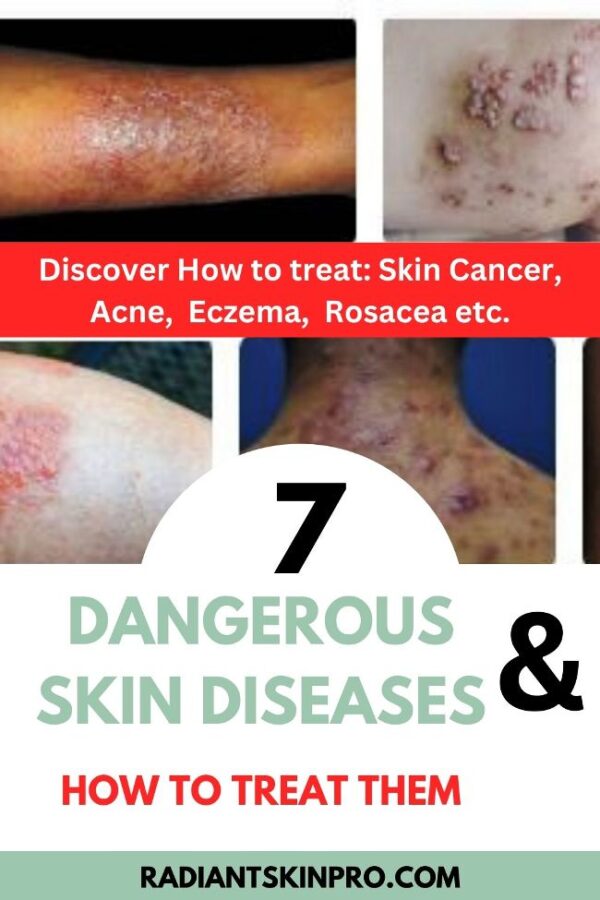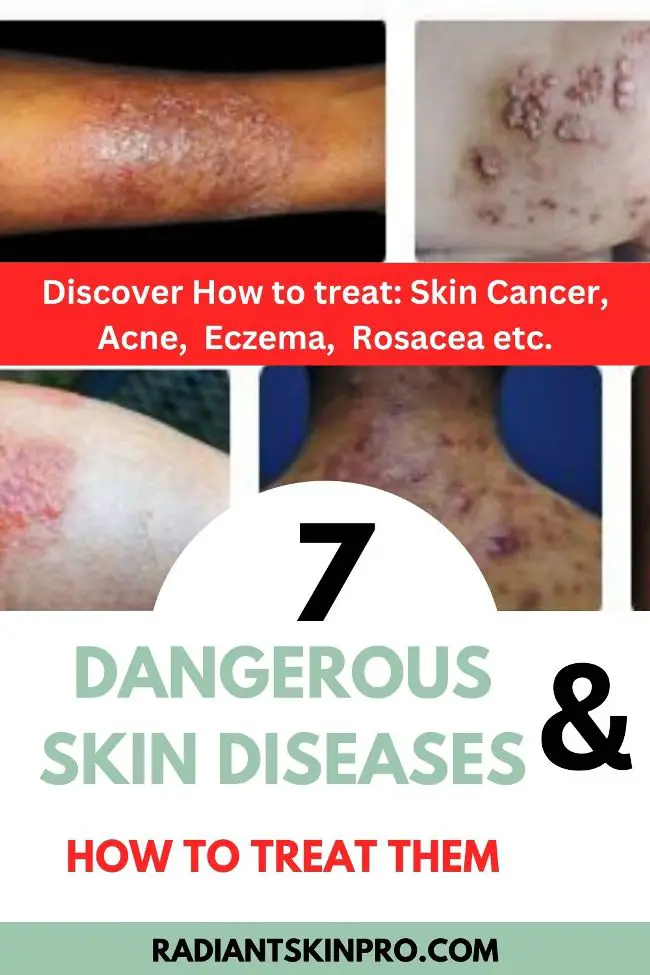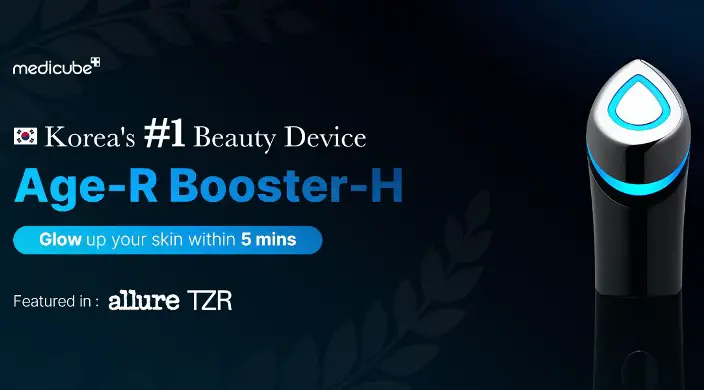Your skin is not just your body’s largest organ; it’s your first line of defense, your canvas for self-expression, and a reflection of your overall health. Imagine your skin as a shield, defending your body against external threats while also reflecting your inner health and beauty.
However, this delicate balance can be disrupted by a range of skin diseases, some of which can be truly dangerous. These conditions not only affect your appearance but also your overall well-being. This remarkable organ is not immune to the challenges that life can throw at it.
Skin diseases can be not only troublesome but also dangerous, impacting your well-being and self-esteem. In this comprehensive exploration, we will delve into seven skin diseases that pose significant risks and challenges but fear not, because we will also uncover the strategies and solutions to conquer them.
From organic remedies rooted in nature’s wisdom to medical interventions designed to restore your skin’s health, this journey is a map to a healthier, more radiant you. Welcome to the guide on “7 Dangerous Skin Diseases and How to Conquer.”
7 Dangerous Skin Diseases and How to Treat Them

1: Skin Cancer
Skin Cancer Overview: Skin cancer is a formidable adversary, with melanoma being the deadliest form. Excessive sun exposure, genetic factors, and a history of severe sunburns can increase the risk of developing skin cancer.
Solution 1: Organic Defense—Sun Protection: To prevent skin cancer, organic solutions like wearing protective clothing and using mineral-based sunscreens can shield your skin from harmful UV radiation. These sunscreens, containing zinc oxide or titanium dioxide, provide a physical barrier, effectively blocking the sun’s harmful rays.
Solution 2: Medical Intervention—Early Detection: Regular skin checks with a dermatologist are vital. They can identify suspicious moles or growths early, increasing the chances of successful treatment. Invasive skin cancer may require surgical removal or advanced treatments like chemotherapy or immunotherapy.
2: Eczema – The Itchy Dilemma
Eczema Overview: Eczema, or atopic dermatitis, is a chronic skin condition characterized by inflamed, itchy skin. Genetics and environmental factors contribute to its development.
Solution 1: Organic Relief – Oatmeal Baths: Organic remedies like soothing oatmeal baths can provide relief from eczema symptoms. Oats contain compounds that reduce inflammation and itching. Adding colloidal oatmeal to your bathwater can help calm irritated skin.
Solution 2: Medical Assistance – Topical Steroids: In severe cases, dermatologists may prescribe topical steroids to manage eczema flare-ups. These medications help reduce inflammation and itching. It’s essential to use them under medical supervision to avoid potential side effects.
3: Psoriasis
Psoriasis Overview: Psoriasis is an autoimmune skin disorder that results in the rapid buildup of skin cells, causing red, scaly patches. Genetics and triggers like stress or infections can exacerbate this condition.
Solution 1: Organic Relief – Moisturizing with Natural Oils: Organic solutions such as applying natural oils like coconut, olive, or jojoba oil can help soothe dry, flaky skin. These oils provide moisture and may reduce scaling.
Solution 2: Medical Intervention – Topical Treatments: Dermatologists often prescribe topical corticosteroids or calcineurin inhibitors to manage psoriasis symptoms. In severe cases, systemic medications or phototherapy may be necessary.
4: Rosacea
Rosacea Overview: Rosacea is a chronic skin condition characterized by facial redness, flushing, visible blood vessels, and sometimes pimple-like bumps. Triggers like spicy foods, alcohol, and sunlight can worsen symptoms.
Solution 1: Organic Soothing – Green Tea: Organic solutions include using green tea topically. Green tea’s anti-inflammatory properties can help reduce redness and soothe irritated skin. Brewed and cooled green tea can be applied as a gentle toner.
Solution 2: Medical Management – Topical and Oral Medications: Dermatologists often prescribe topical medications containing metronidazole or azelaic acid to manage rosacea. For more severe cases, oral antibiotics or laser therapy may be recommended.
5: Vitiligo
Vitiligo Overview: Vitiligo is a skin disorder that causes loss of skin color in patches. The exact cause is still unclear, but it is believed to involve an autoimmune component.
Solution 1: Organic Camouflage – Makeup: Organic makeup products, free of harmful chemicals, can help conceal vitiligo patches. Mineral-based foundations can provide good coverage while being gentle on the skin.
Solution 2: Medical Treatments: Phototherapy and Topical Corticosteroids: Medical interventions for vitiligo include phototherapy, which exposes the affected areas to ultraviolet A (UVA) or ultraviolet B (UVB) light, and topical corticosteroids to help repigment the skin. Consultation with a dermatologist is essential for personalized treatment.
6: Hives (Urticaria)
Hives Overview: Hives are raised, itchy welts that can appear suddenly due to allergic reactions, stress, or certain medications. They can be intensely uncomfortable and often resolve on their own.
Solution 1: Organic Relief – Cool Compresses: Applying cold compresses to hives can provide immediate relief. Simply place a cloth soaked in cold water on the affected area for a few minutes to reduce itching and inflammation.
Solution 2: Medical Assistance – Antihistamines: Over-the-counter or prescription antihistamines can effectively relieve hives by blocking the histamine response. Consult a healthcare professional for proper guidance and dosage.
7: Scabies – The Tiny Invaders
Scabies Overview: Scabies is a highly contagious skin infestation caused by the microscopic mite Sarcoptes scabiei. It leads to intense itching and a red, bumpy rash, often in the webbing between fingers, wrists, elbows, and other warm, moist areas.
Solution 1: Organic Approach – Neem Oil: Neem oil, derived from the neem tree, has natural antiparasitic properties and can help alleviate scabies symptoms. Applying neem oil to affected areas may help reduce itching and promote healing.
Solution 2: Medical Intervention – Prescription Medications: Scabies typically requires prescription medications, such as topical permethrin or oral ivermectin, to effectively eliminate the mites and their eggs. It’s crucial to follow your healthcare provider’s instructions for treatment.
Conclusion
Skin diseases can be daunting, affecting not only your appearance but also your overall health and well-being. However, armed with the knowledge of these conditions and their potential solutions, you can take proactive steps to conquer them.
Organic remedies offer gentle, natural relief, while medical interventions, when necessary, provide effective treatments under professional guidance.
Remember that every individual’s skin is unique, and what works best may vary from person to person. Consultation with a dermatologist or healthcare professional is essential for accurate diagnosis and personalized treatment plans.
With the right approach, you can overcome these skin diseases and restore your skin’s health and radiance, enhancing both your confidence and your quality of life.
References
Goh, C. L. (2015). Allergic contact dermatitis to cosmetics. Dermatology Research and Practice, 2015, 747258. https://doi.org/10.1155/2015/747258
Cunliffe, W. J., Goulden, V., & Lever, L. (1998). Perioral dermatitis: A clinical and therapeutic review. British Journal of Dermatology, 141(5), 846–852. https://doi.org/10.1046/j.1365-2133.1998.02442.x


